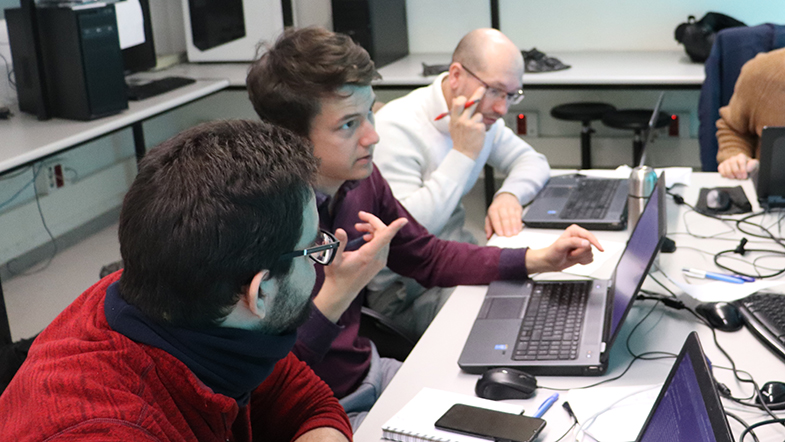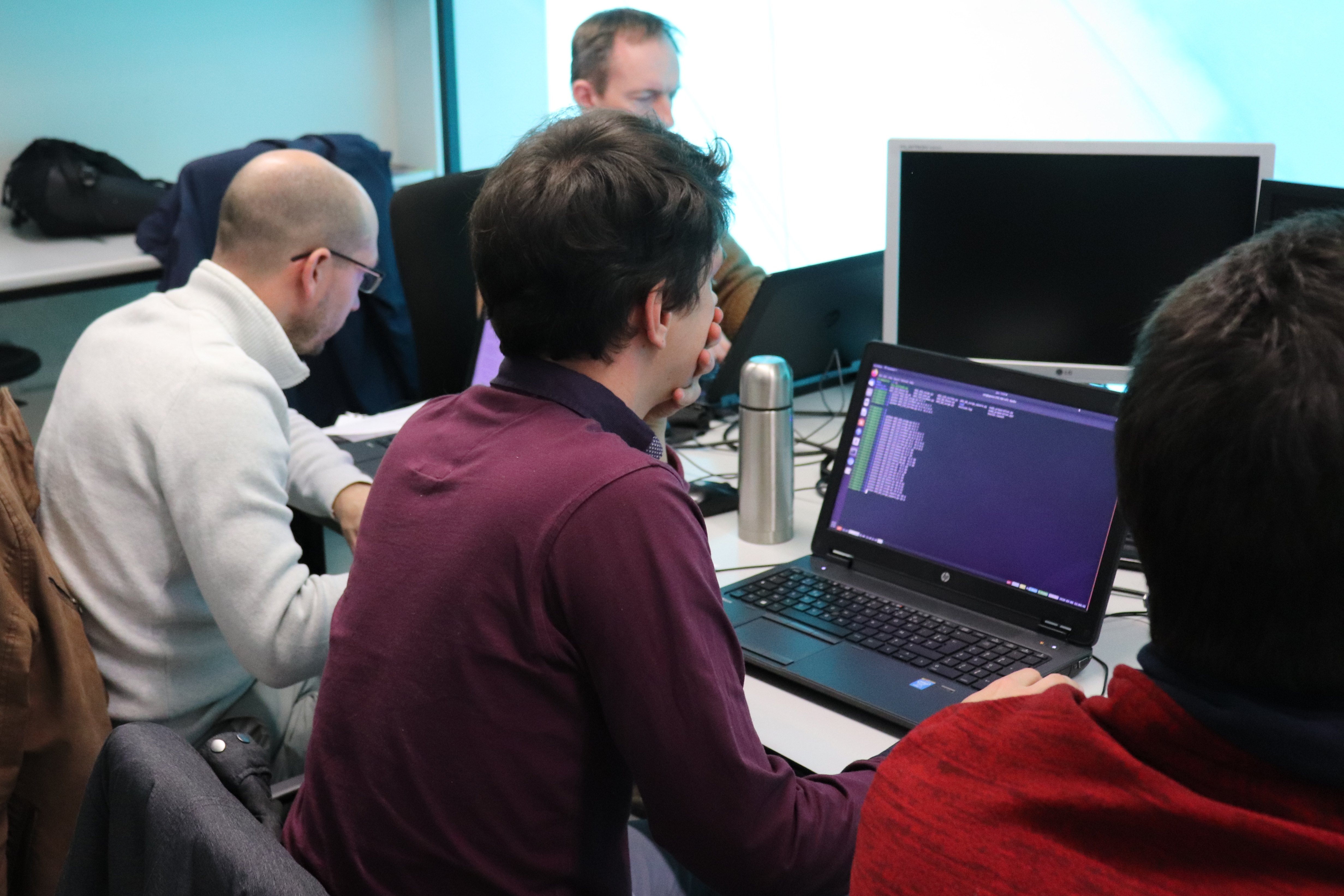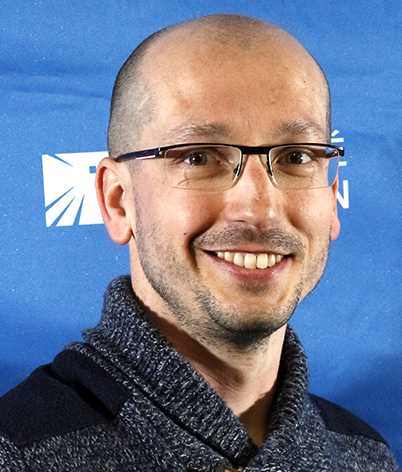Abstract
Keywords : Hydrodynamic parameters, SPH, Numerical method, Interaction, Fluid-solid, Fluid-structure, Incompressible flow, Underwater robotics.
Laboratoire COSMER – RNSR 201522018X
EA 7398 – COnception de Systèmes Mécaniques et Robotiques – Mechanical and Robotic Systems
Keywords : Hydrodynamic parameters, SPH, Numerical method, Interaction, Fluid-solid, Fluid-structure, Incompressible flow, Underwater robotics.
Additive manufacturing of tubes by multi-axis robotized wire deposition :
Trajectory generation and optimization
Additive manufacturing through Directed Energy Deposition (DED) enables small batches
of parts to be rapidly manufactured. However, manufacturing trajectories usually used
for the manufacture of overhanging parts require the use of supports, material which
is not useful for the finished part and time consuming. If multi-axis trajectories can be
used to avoid them, they present generally a heterogeneous local inter-layer distance, thus
requiring a variation of the deposition parameters to adapt the layer height ; variation that
can be harmful to the mechanical characteristics of the final part. This thesis first proposes
a constant local inter-layer trajectory generation method for DED additive manufacturing
of tubular parts defined by parametric curves and which can have profile radius variations.
The proposed trajectories have been validated by robotized manufacturing trials of polymer
parts. Since the rotation about a coaxial deposition tool axis has no impact on the deposit,
the use of 6-axis robots offers a redundancy. Using this redundancy, a layer by layer
optimization of the trajectory in the robot space is then proposed. In a constrained robot
configuration, the trajectory optimization allows the manufacturing of parts that cannot
be manufactured in the usual way, and improves the geometrical quality of the parts with
a better repeatability.
Nicolas and Mathieu were in Girona in March to carry out experiments in the basins of the CIRS (Centre d’Investigació en Robòtica Submarina). These facilities are made available to foreign researchers as part of the EUMarineRobots project.
On this occasion, they answered questions from our Spanish colleagues.
 From the 2nd to the 6th of March, a team of researchers and students of the Université de Toulon have been carrying out experiments at the facilities of the CIRS.
From the 2nd to the 6th of March, a team of researchers and students of the Université de Toulon have been carrying out experiments at the facilities of the CIRS.
These tests allowed them to collect real data regarding the dynamic behaviour of SPARUS AUV which will be compared with the data from the simulator they are developing in order to improve their predictions.
This action has been possible thanks to the Trans-National Access (TNA) offered by the European project EUMarineRobots. The main objective of the EUMR project is to open up key national and regional marine robotics research infrastructures to all European researchers, from both academia and industry, ensuring their optimal use and joint development to establish a world-class marine robotics integrated infrastructure.
If you are a student, industrial researcher and academic or entrepreneur and you are interested in applying for a TNA to carry out experiments with Girona500 AUV or Sparus II AUV, you have time to apply until the 15th of April 2020!
https://www.eumarinerobots.eu/tna-3rdcall

(from https://vicorob.udg.edu/tna-experiments-in-the-vicorobs-infrastructures/)

Dr. Andrew Comport, CNRS researcher at the I3S laboratory of the University of the Côte d’Azur, will give a seminar entitled “Localisation and dense mapping for autonomous navigation” on Monday 27 January at 10:30 am at Ifremer (La Seyne Sur Mer, Brégaillon area).
Abstract
In this talk, he will present advanced computer vision approaches for real-time dense location and mapping that have been developed in the context of the European H2020 COMANOID project to control and navigate humanoid robots using dense perception. First, it will show how dense localization and mapping models can be computed in real time to allow precise and robust interaction with 3D scene surfaces. He will present recent advances that integrate temporally, in addition to 3D geometry, the color information contained in images. This will involve defining an inverse super-resolution model for many low-resolution images acquired from different camera poses. In contrast to conventional super-resolution techniques, this is achieved here by taking into account the complete 6D motion transformations as well as the surface structure of the scene.
In a second part, he will present a real-time model for the acquisition of 3D light fields in “High Dynamic Range” (HDR) from several moving images with different exposures (sensor integration periods). In particular, an RGB-D camera will be used as a dynamic light field sensor. Another augmented reality application will be presented that demonstrates the wider use of real-time 3D HDR mapping, virtual light probe synthesis and light source detection to make objects reflective with shadows and transparent with the real-time video stream.
Bio:
Andrew Comport is a CNRS researcher assigned to the I3S laboratory at the University Cote d’Azur. His research focuses on the fields of computer vision, robotics, machine learning and visual servoing. In 2015, he co-founded the start-up PIXMAP, specialized in real-time localization and mapping based on several patents and software. He defended his thesis at INRIA Rennes in 2005 and did a postdoc at INRIA Sophia-Antipolis until 2007. Prior to that, he obtained a double degree in Engineering and Computer Science at Monash University in Australia. He is author of more than 50 international publications among which he won the best paper award at the IEEE/RSJ IROS international conference in 2013. He is currently Associate Editor of the IEEE International Conference on Robotics and Automation (ICRA) and Robotics and Automation Letters (RAL).
Translated with www.DeepL.com/Translator (free version)

“This thesis addresses the problem of tether shape control for small remotely operated underwater vehicles (mini-ROVs), which are suitable, thanks to their small size and high maneuverability, for the exploration of shallow waters and cluttered spaces. The management of the tether is, however, a hard task, since these robots do not have enough propulsion power to counterbalance the drag forces acting on the tether cable. In order to cope with this problem, we introduced the concept of a Chain of mini-ROVs, where several robots are linked to the tether cable and can, together, manage the external perturbations and control the shape of the cable.
We investigated the use of the embedded cameras to regulate the shape of a portion of tether linking two successive robots, a leader and a follower. Only the follower robot deals with the tether shape regulation task. The leader is released to explore its surroundings. The tether linking both robots is assumed to be negatively buoyant and is modeled by a catenary. The tether shape parameters are estimated in real-time by a nonlinear optimization procedure that fits the catenary model to the tether detected points in the image. The shape parameter regulation is thus achieved through a catenary-based control scheme relating the robot motion with the tether shape variation. The proposed visual servoing control scheme has proved to properly manage the tether shape in simulations and real experiments in pool.”
David Navarro-Alarcon will give a talk on thursday the 25th at 4PM, room 133 X building, Title Shape Servoing of Deformable Objects: Modelling, Estimation, and Control Abstract Over Read more →

This week, Matheus is validating his ‘chain of robots’ concept with two bluerovs in the pool.
This year again, the University of Toulon invites you to the Théâtre Liberté for an evening event around the research activities of doctoral students and young researchers. 12 doctoral students and 7 researchers will undergo a perilous exercise: present their research in a limited time in a theatrical and imaginative way for all audiences.
The COSMER laboratory will be represented by Ornella Tortorici and Mathieu Richier. Come and support them!


We invite you to attend the next COSMER seminar on Thursday, January 31 at 1:30 pm in room M141.
On this occasion, Benjamin OSTRE will present his research projects in the COSMER laboratory and his teaching projects in the Seatech school.
